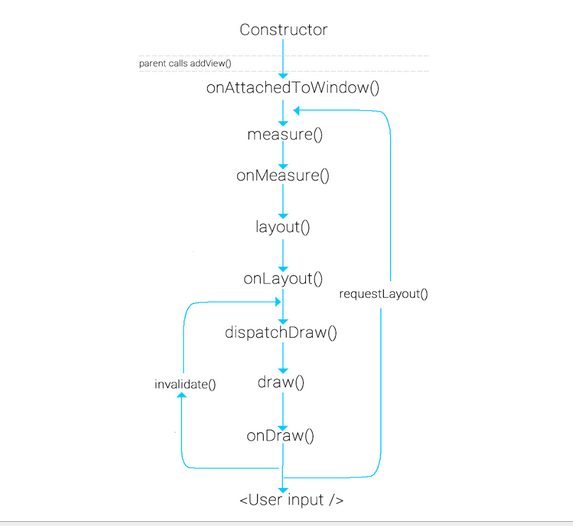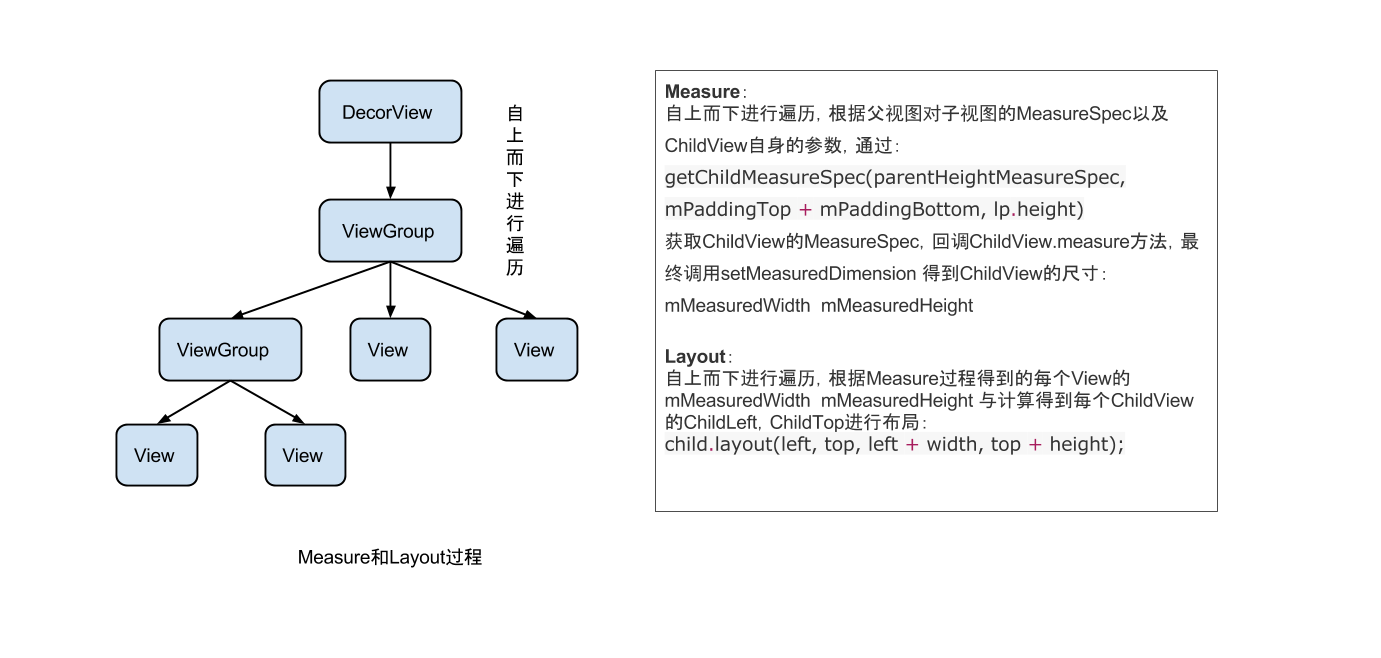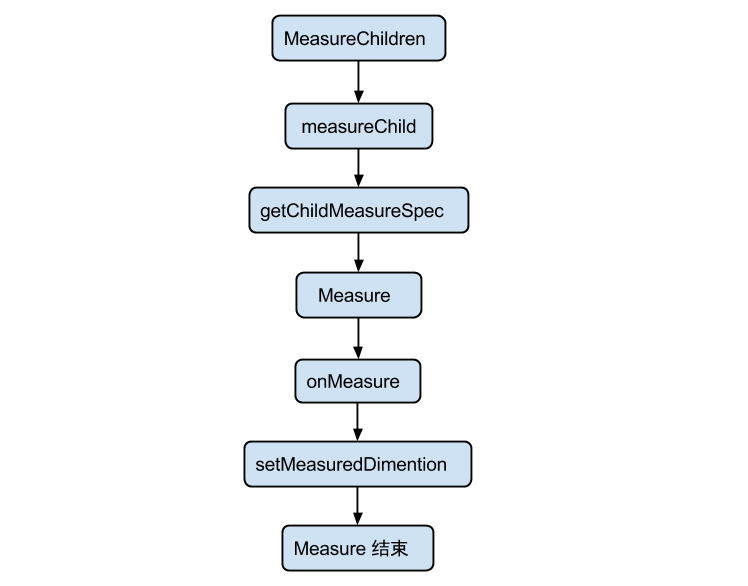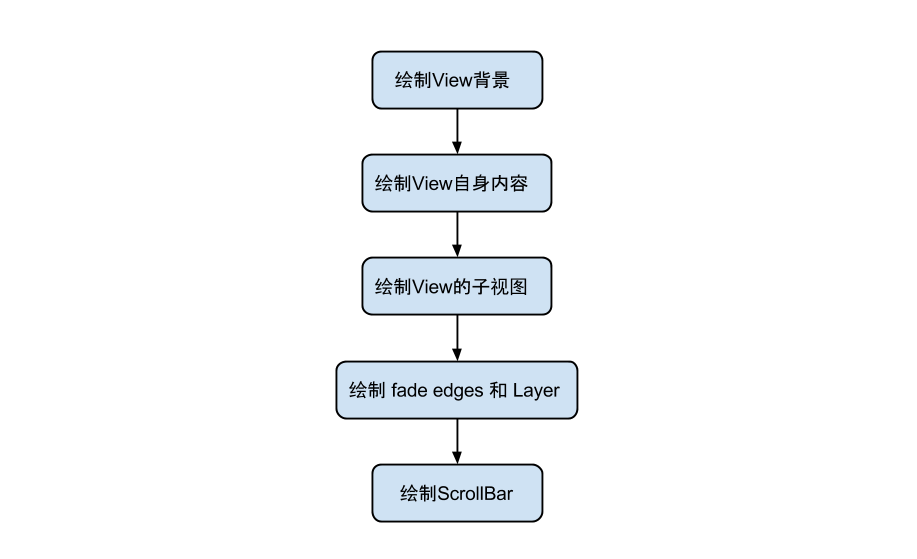版權信息
鏈接:[公共技術點之 View 繪制流程](http://www.codekk.com/blogs/detail/54cfab086c4761e5001b253f)
---
個人簡述
---
> 本文為?[Android 開源項目源碼解析](http://a.codekk.com/)?公共技術點中的 View 繪制流程 部分
> 分析者:[lightSky](https://github.com/lightSky)
#### View 繪制機制
##### 1\. View 樹的繪圖流程
當 Activity 接收到焦點的時候,它會被請求繪制布局,該請求由 Android framework 處理.繪制是從根節點開始,對布局樹進行 measure 和 draw。整個 View 樹的繪圖流程在`ViewRoot.java`類的`performTraversals()`函數展開,該函數所做 的工作可簡單概況為是否需要重新計算視圖大小(measure)、是否需要重新安置視圖的位置(layout)、以及是否需要重繪(draw),流程圖如下:

View 繪制流程函數調用鏈

圖片來自?[https://plus.google.com/+ArpitMathur/posts/cT1EuBbxEgN](https://plus.google.com/+ArpitMathur/posts/cT1EuBbxEgN)
需要說明的是,用戶主動調用 request,只會出發 measure 和 layout 過程,而不會執行 draw 過程
##### 2\. 概念
measure 和 layout
從整體上來看 Measure 和 Layout 兩個步驟的執行:?
樹的遍歷是有序的,由父視圖到子視圖,每一個 ViewGroup 負責測繪它所有的子視圖,而最底層的 View 會負責測繪自身。
具體分析
measure 過程由`measure(int, int)`方法發起,從上到下有序的測量 View,在 measure 過程的最后,每個視圖存儲了自己的尺寸大小和測量規格。 layout 過程由`layout(int, int, int, int)`方法發起,也是自上而下進行遍歷。在該過程中,每個父視圖會根據 measure 過程得到的尺寸來擺放自己的子視圖。
measure 過程會為一個 View 及所有子節點的 mMeasuredWidth 和 mMeasuredHeight 變量賦值,該值可以通過?`getMeasuredWidth()`和`getMeasuredHeight()`方法獲得。而且這兩個值必須在父視圖約束范圍之內,這樣才可以保證所有的父視圖都接收所有子視圖的測量。如果子視圖對于 Measure 得到的大小不滿意的時候,父視圖會介入并設置測量規則進行第二次 measure。比如,父視圖可以先根據未給定的 dimension 去測量每一個子視圖,如果最終子視圖的未約束尺寸太大或者太小的時候,父視圖就會使用一個確切的大小再次對子視圖進行 measure。
measure 過程傳遞尺寸的兩個類
* ViewGroup.LayoutParams (View 自身的布局參數)
* MeasureSpecs 類(父視圖對子視圖的測量要求)
ViewGroup.LayoutParams
這個類我們很常見,就是用來指定視圖的高度和寬度等參數。對于每個視圖的 height 和 width,你有以下選擇:
* 具體值
* MATCH_PARENT 表示子視圖希望和父視圖一樣大(不包含 padding 值)
* WRAP_CONTENT 表示視圖為正好能包裹其內容大小(包含 padding 值)
ViewGroup 的子類有其對應的 ViewGroup.LayoutParams 的子類。比如 RelativeLayout 擁有的 ViewGroup.LayoutParams 的子類 RelativeLayoutParams。
有時我們需要使用 view.getLayoutParams() 方法獲取一個視圖 LayoutParams,然后進行強轉,但由于不知道其具體類型,可能會導致強轉錯誤。其實該方法得到的就是其所在父視圖類型的 LayoutParams,比如 View 的父控件為 RelativeLayout,那么得到的 LayoutParams 類型就為 RelativeLayoutParams。
MeasureSpecs
測量規格,包含測量要求和尺寸的信息,有三種模式:
* UNSPECIFIED
父視圖不對子視圖有任何約束,它可以達到所期望的任意尺寸。比如 ListView、ScrollView,一般自定義 View 中用不到,
* EXACTLY
父視圖為子視圖指定一個確切的尺寸,而且無論子視圖期望多大,它都必須在該指定大小的邊界內,對應的屬性為 match_parent 或具體值,比如 100dp,父控件可以通過`MeasureSpec.getSize(measureSpec)`直接得到子控件的尺寸。
* AT_MOST
父視圖為子視圖指定一個最大尺寸。子視圖必須確保它自己所有子視圖可以適應在該尺寸范圍內,對應的屬性為 wrap_content,這種模式下,父控件無法確定子 View 的尺寸,只能由子控件自己根據需求去計算自己的尺寸,這種模式就是我們自定義視圖需要實現測量邏輯的情況。
##### 3\. measure 核心方法
* measure(int widthMeasureSpec, int heightMeasureSpec)
該方法定義在`View.java`類中,為 final 類型,不可被復寫,但 measure 調用鏈最終會回調 View/ViewGroup 對象的?`onMeasure()`方法,因此自定義視圖時,只需要復寫?`onMeasure()`?方法即可。
* onMeasure(int widthMeasureSpec, int heightMeasureSpec)
該方法就是我們自定義視圖中實現測量邏輯的方法,該方法的參數是父視圖對子視圖的 width 和 height 的測量要求。在我們自身的自定義視圖中,要做的就是根據該 widthMeasureSpec 和 heightMeasureSpec 計算視圖的 width 和 height,不同的模式處理方式不同。
* setMeasuredDimension()
測量階段終極方法,在?`onMeasure(int widthMeasureSpec, int heightMeasureSpec)`方法中調用,將計算得到的尺寸,傳遞給該方法,測量階段即結束。該方法也是必須要調用的方法,否則會報異常。在我們在自定義視圖的時候,不需要關心系統復雜的 Measure 過程的,只需調用`setMeasuredDimension()`設置根據 MeasureSpec 計算得到的尺寸即可,你可以參考?[ViewPagerIndicator](http://a.codekk.com/detail/Android/lightSky/ViewPagerindicator%20%E6%BA%90%E7%A0%81%E8%A7%A3%E6%9E%90)?的 onMeasure 方法。
下面我們取 ViewGroup 的?`measureChildren(int widthMeasureSpec, int heightMeasureSpec)`?方法對復合 View 的 Measure 流程做一個分析: MeasureChild 的方法調用流程圖:

源碼分析
~~~
/**
* 請求所有子 View 去 measure 自己,要考慮的部分有對子 View 的測繪要求 MeasureSpec 以及其自身的 padding
* 這里跳過所有為 GONE 狀態的子 View,最繁重的工作是在 getChildMeasureSpec 方法中處理的
*
* @param widthMeasureSpec 對該 View 的 width 測繪要求
* @param heightMeasureSpec 對該 View 的 height 測繪要求
*/
protected void measureChildren(int widthMeasureSpec, int heightMeasureSpec) {
final int size = mChildrenCount;
final View[] children = mChildren;
for (int i = 0; i < size; ++i) {
final View child = children[i];
if ((child.mViewFlags & VISIBILITY_MASK) != GONE) {
measureChild(child, widthMeasureSpec, heightMeasureSpec);
}
}
}
protected void measureChild(View child, int parentWidthMeasureSpec,
int parentHeightMeasureSpec) {
final LayoutParams lp = child.getLayoutParams();//獲取 Child 的 LayoutParams
final int childWidthMeasureSpec = getChildMeasureSpec(parentWidthMeasureSpec,// 獲取 ChildView 的 widthMeasureSpec
mPaddingLeft + mPaddingRight, lp.width);
final int childHeightMeasureSpec = getChildMeasureSpec(parentHeightMeasureSpec,// 獲取 ChildView 的 heightMeasureSpec
mPaddingTop + mPaddingBottom, lp.height);
child.measure(childWidthMeasureSpec, childHeightMeasureSpec);
}
/**
* 該方法是 measureChildren 中最繁重的部分,為每一個 ChildView 計算出自己的 MeasureSpec。
* 目標是將 ChildView 的 MeasureSpec 和 LayoutParams 結合起來去得到一個最合適的結果。
*
* @param spec 對該 View 的測繪要求
* @param padding 當前 View 在當前唯獨上的 paddingand,也有可能含有 margins
*
* @param childDimension 在當前維度上(height 或 width)的具體指
* @return 子視圖的 MeasureSpec
*/
public static int getChildMeasureSpec(int spec, int padding, int childDimension) {
.........
// 根據獲取到的子視圖的測量要求和大小創建子視圖的 MeasureSpec
return MeasureSpec.makeMeasureSpec(resultSize, resultMode);
}
/**
*
* 用于獲取 View 最終的大小,父視圖提供了寬、高的約束信息
* 一個 View 的真正的測量工作是在 onMeasure(int, int) 中,由該方法調用。
* 因此,只有 onMeasure(int, int) 可以而且必須被子類復寫
*
* @param widthMeasureSpec 在水平方向上,父視圖指定的的 Measure 要求
* @param heightMeasureSpec 在豎直方向上,控件上父視圖指定的 Measure 要求
*
*/
public final void measure(int widthMeasureSpec, int heightMeasureSpec) {
...
onMeasure(widthMeasureSpec, heightMeasureSpec);
...
}
protected void onMeasure(int widthMeasureSpec, int heightMeasureSpec) {
setMeasuredDimension(getDefaultSize(getSuggestedMinimumWidth(), widthMeasureSpec),
getDefaultSize(getSuggestedMinimumHeight(), heightMeasureSpec));
}
~~~
##### 4\. layout 相關概念及核心方法
首先要明確的是,子視圖的具體位置都是相對于父視圖而言的。View 的 onLayout 方法為空實現,而 ViewGroup 的 onLayout 為 abstract 的,因此,如果自定義的 View 要繼承 ViewGroup 時,必須實現 onLayout 函數。
在 layout 過程中,子視圖會調用`getMeasuredWidth()`和`getMeasuredHeight()`方法獲取到 measure 過程得到的 mMeasuredWidth 和 mMeasuredHeight,作為自己的 width 和 height。然后調用每一個子視圖的`layout(l, t, r, b)`函數,來確定每個子視圖在父視圖中的位置。
LinearLayout 的 onLayout 源碼分析
~~~
@Override
protected void onLayout(boolean changed, int l, int t, int r, int b) {
if (mOrientation == VERTICAL) {
layoutVertical(l, t, r, b);
} else {
layoutHorizontal(l, t, r, b);
}
}
/**
* 遍歷所有的子 View,為其設置相對父視圖的坐標
*/
void layoutVertical(int left, int top, int right, int bottom) {
for (int i = 0; i < count; i++) {
final View child = getVirtualChildAt(i);
if (child == null) {
childTop += measureNullChild(i);
} else if (child.getVisibility() != GONE) {//不需要立即展示的 View 設置為 GONE 可加快繪制
final int childWidth = child.getMeasuredWidth();//measure 過程確定的 Width
final int childHeight = child.getMeasuredHeight();//measure 過程確定的 height
...確定 childLeft、childTop 的值
setChildFrame(child, childLeft, childTop + getLocationOffset(child),
childWidth, childHeight);
}
}
}
private void setChildFrame(View child, int left, int top, int width, int height) {
child.layout(left, top, left + width, top + height);
}
View.java
public void layout(int l, int t, int r, int b) {
...
setFrame(l, t, r, b)
}
/**
* 為該子 View 設置相對其父視圖上的坐標
*/
protected boolean setFrame(int left, int top, int right, int bottom) {
...
}
~~~
##### 5\. 繪制流程相關概念及核心方法
先來看下與 draw 過程相關的函數:
* View.draw(Canvas canvas): 由于 ViewGroup 并沒有復寫此方法,因此,所有的視圖最終都是調用 View 的 draw 方法進行繪制的。在自定義的視圖中,也不應該復寫該方法,而是復寫?`onDraw(Canvas)`?方法進行繪制,如果自定義的視圖確實要復寫該方法,那么請先調用?`super.draw(canvas)`完成系統的繪制,然后再進行自定義的繪制。
* View.onDraw():
View 的`onDraw(Canvas)`默認是空實現,自定義繪制過程需要復寫的方法,繪制自身的內容。
* dispatchDraw() 發起對子視圖的繪制。View 中默認是空實現,ViewGroup 復寫了`dispatchDraw()`來對其子視圖進行繪制。該方法我們不用去管,自定義的 ViewGroup 不應該對`dispatchDraw()`進行復寫。
繪制流程圖

- View.draw(Canvas) 源碼分析
~~~
/**
* Manually render this view (and all of its children) to the given Canvas.
* The view must have already done a full layout before this function is
* called. When implementing a view, implement
* {@link #onDraw(android.graphics.Canvas)} instead of overriding this method.
* If you do need to override this method, call the superclass version.
*
* @param canvas The Canvas to which the View is rendered.
*
* 根據給定的 Canvas 自動渲染 View(包括其所有子 View)。在調用該方法之前必須要完成 layout。當你自定義 view 的時候,
* 應該去是實現 onDraw(Canvas) 方法,而不是 draw(canvas) 方法。如果你確實需要復寫該方法,請記得先調用父類的方法。
*/
public void draw(Canvas canvas) {
/ * Draw traversal performs several drawing steps which must be executed
* in the appropriate order:
*
* 1\. Draw the background if need
* 2\. If necessary, save the canvas' layers to prepare for fading
* 3\. Draw view's content
* 4\. Draw children (dispatchDraw)
* 5\. If necessary, draw the fading edges and restore layers
* 6\. Draw decorations (scrollbars for instance)
*/
// Step 1, draw the background, if needed
if (!dirtyOpaque) {
drawBackground(canvas);
}
// skip step 2 & 5 if possible (common case)
final int viewFlags = mViewFlags;
if (!verticalEdges && !horizontalEdges) {
// Step 3, draw the content
if (!dirtyOpaque) onDraw(canvas);
// Step 4, draw the children
dispatchDraw(canvas);
// Step 6, draw decorations (scrollbars)
onDrawScrollBars(canvas);
if (mOverlay != null && !mOverlay.isEmpty()) {
mOverlay.getOverlayView().dispatchDraw(canvas);
}
// we're done...
return;
}
// Step 2, save the canvas' layers
...
// Step 3, draw the content
if (!dirtyOpaque)
onDraw(canvas);
// Step 4, draw the children
dispatchDraw(canvas);
// Step 5, draw the fade effect and restore layers
// Step 6, draw decorations (scrollbars)
onDrawScrollBars(canvas);
}
~~~
由上面的處理過程,我們也可以得出一些優化的小技巧:當不需要繪制 Layer 的時候第二步和第五步會跳過。因此在繪制的時候,能省的 layer 盡可省,可以提高繪制效率
ViewGroup.dispatchDraw() 源碼分析
~~~
dispatchDraw(Canvas canvas){
...
if ((flags & FLAG_RUN_ANIMATION) != 0 && canAnimate()) {//處理 ChildView 的動畫
final boolean buildCache = !isHardwareAccelerated();
for (int i = 0; i < childrenCount; i++) {
final View child = children[i];
if ((child.mViewFlags & VISIBILITY_MASK) == VISIBLE) {//只繪制 Visible 狀態的布局,因此可以通過延時加載來提高效率
final LayoutParams params = child.getLayoutParams();
attachLayoutAnimationParameters(child, params, i, childrenCount);// 添加布局變化的動畫
bindLayoutAnimation(child);//為 Child 綁定動畫
if (cache) {
child.setDrawingCacheEnabled(true);
if (buildCache) {
child.buildDrawingCache(true);
}
}
}
}
final LayoutAnimationController controller = mLayoutAnimationController;
if (controller.willOverlap()) {
mGroupFlags |= FLAG_OPTIMIZE_INVALIDATE;
}
controller.start();// 啟動 View 的動畫
}
// 繪制 ChildView
for (int i = 0; i < childrenCount; i++) {
int childIndex = customOrder ? getChildDrawingOrder(childrenCount, i) : i;
final View child = (preorderedList == null)
? children[childIndex] : preorderedList.get(childIndex);
if ((child.mViewFlags & VISIBILITY_MASK) == VISIBLE || child.getAnimation() != null) {
more |= drawChild(canvas, child, drawingTime);
}
}
...
}
protected boolean drawChild(Canvas canvas, View child, long drawingTime) {
return child.draw(canvas, this, drawingTime);
}
/**
* This method is called by ViewGroup.drawChild() to have each child view draw itself.
* This draw() method is an implementation detail and is not intended to be overridden or
* to be called from anywhere else other than ViewGroup.drawChild().
*/
boolean draw(Canvas canvas, ViewGroup parent, long drawingTime) {
...
}
~~~
* drawChild(canvas, this, drawingTime)
直接調用了 View 的`child.draw(canvas, this,drawingTime)`方法,文檔中也說明了,除了被`ViewGroup.drawChild()`方法外,你不應該在其它任何地方去復寫或調用該方法,它屬于 ViewGroup。而`View.draw(Canvas)`方法是我們自定義控件中可以復寫的方法,具體可以參考上述對`view.draw(Canvas)`的說明。從參數中可以看到,`child.draw(canvas, this, drawingTime)`?肯定是處理了和父視圖相關的邏輯,但 View 的最終繪制,還是?`View.draw(Canvas)`方法。
* invalidate()
請求重繪 View 樹,即 draw 過程,假如視圖發生大小沒有變化就不會調用`layout()`過程,并且只繪制那些調用了`invalidate()`方法的 View。
* requestLayout()
當布局變化的時候,比如方向變化,尺寸的變化,會調用該方法,在自定義的視圖中,如果某些情況下希望重新測量尺寸大小,應該手動去調用該方法,它會觸發`measure()`和`layout()`過程,但不會進行 draw。
參考資料
[how-android-draws](http://developer.android.com/guide/topics/ui/how-android-draws.html)
[http://blog.csdn.net/wangjinyu501/article/details/9008271](http://blog.csdn.net/wangjinyu501/article/details/9008271)
[http://blog.csdn.net/qinjuning/article/details/7110211](http://blog.csdn.net/qinjuning/article/details/7110211)
[http://blog.csdn.net/qinjuning/article/details/8074262](http://blog.csdn.net/qinjuning/article/details/8074262)
- 0-發現
- AndroidInterview-Q-A
- Android能讓你少走彎路的干貨整理
- LearningNotes
- temp
- temp11
- 部分地址
- 0-待辦任務
- 待補充列表
- 0-未分類
- AndroidView事件分發與滑動沖突處理
- Spannable
- 事件分發機制詳解
- 1-Java
- 1-Java-01基礎
- 未歸檔
- 你應該知道的JDK知識
- 集合框架
- 1-Java-04合集
- Java之旅0
- Java之旅
- JAVA之旅01
- JAVA之旅02
- JAVA之旅03
- JAVA之旅04
- JAVA之旅05
- JAVA之旅06
- JAVA之旅07
- JAVA之旅08
- JAVA之旅09
- java之旅1
- JAVA之旅10
- JAVA之旅11
- JAVA之旅12
- JAVA之旅13
- JAVA之旅14
- JAVA之旅15
- JAVA之旅16
- JAVA之旅17
- JAVA之旅18
- JAVA之旅19
- java之旅2
- JAVA之旅20
- JAVA之旅21
- JAVA之旅22
- JAVA之旅23
- JAVA之旅24
- JAVA之旅25
- JAVA之旅26
- JAVA之旅27
- JAVA之旅28
- JAVA之旅29
- java之旅3
- JAVA之旅30
- JAVA之旅31
- JAVA之旅32
- JAVA之旅33
- JAVA之旅34
- JAVA之旅35
- 1-Java-05辨析
- HashMapArrayMap
- Java8新特性
- Java8接口默認方法
- 圖解HashMap(1)
- 圖解HashMap(2)
- 2-Android
- 2-Android-1-基礎
- View繪制流程
- 事件分發
- AndroidView的事件分發機制和滑動沖突解決
- 自定義View基礎
- 1-安卓自定義View基礎-坐標系
- 2-安卓自定義View基礎-角度弧度
- 3-安卓自定義View基礎-顏色
- 自定義View進階
- 1-安卓自定義View進階-分類和流程
- 10-安卓自定義View進階-Matrix詳解
- 11-安卓自定義View進階-MatrixCamera
- 12-安卓自定義View進階-事件分發機制原理
- 13-安卓自定義View進階-事件分發機制詳解
- 14-安卓自定義View進階-MotionEvent詳解
- 15-安卓自定義View進階-特殊形狀控件事件處理方案
- 16-安卓自定義View進階-多點觸控詳解
- 17-安卓自定義View進階-手勢檢測GestureDetector
- 2-安卓自定義View進階-繪制基本圖形
- 3-安卓自定義View進階-畫布操作
- 4-安卓自定義View進階-圖片文字
- 5-安卓自定義View進階-Path基本操作
- 6-安卓自定義View進階-貝塞爾曲線
- 7-安卓自定義View進階-Path完結篇偽
- 8-安卓自定義View進階-Path玩出花樣PathMeasure
- 9-安卓自定義View進階-Matrix原理
- 通用類介紹
- Application
- 2-Android-2-使用
- 2-Android-02控件
- ViewGroup
- ConstraintLayout
- CoordinatorLayout
- 2-Android-03三方使用
- Dagger2
- Dagger2圖文完全教程
- Dagger2最清晰的使用教程
- Dagger2讓你愛不釋手-終結篇
- Dagger2讓你愛不釋手-重點概念講解、融合篇
- dagger2讓你愛不釋手:基礎依賴注入框架篇
- 閱讀筆記
- Glide
- Google推薦的圖片加載庫Glide:最新版使用指南(含新特性)
- rxjava
- 這可能是最好的RxJava2.x入門教程完結版
- 這可能是最好的RxJava2.x入門教程(一)
- 這可能是最好的RxJava2.x入門教程(三)
- 這可能是最好的RxJava2.x入門教程(二)
- 這可能是最好的RxJava2.x入門教程(五)
- 這可能是最好的RxJava2.x入門教程(四)
- 2-Android-3-優化
- 優化概況
- 各種優化
- Android端秒開優化
- apk大小優化
- 內存分析
- 混淆
- 2-Android-4-工具
- adb命令
- 一鍵分析Android的BugReport
- 版本控制
- git
- git章節簡述
- 2-Android-5-源碼
- HandlerThread 源碼分析
- IntentService的使用和源碼分析
- 2-Android-9-辨析
- LRU算法
- 什么是Bitmap
- 常見圖片壓縮方式
- 3-Kotlin
- Kotlin使用筆記1-草稿
- Kotlin使用筆記2
- kotlin特性草稿
- Kotlin草稿-Delegation
- Kotlin草稿-Field
- Kotlin草稿-object
- 4-JavaScript
- 5-Python
- 6-Other
- Git
- Gradle
- Android中ProGuard配置和總結
- gradle使用筆記
- Nexus私服搭建
- 編譯提速最佳實踐
- 7-設計模式與架構
- 組件化
- 組件化探索(OKR)
- 1-參考列表
- 2-1-組件化概述
- 2-2-gradle配置
- 2-3-代碼編寫
- 2-4-常見問題
- 2-9-值得一讀
- 8-數據結構與算法
- 0臨時文件
- 漢諾塔
- 8-數據-1數據結構
- HashMap
- HashMap、Hashtable、HashSet 和 ConcurrentHashMap 的比較
- 遲到一年HashMap解讀
- 8-數據-2算法
- 1個就夠了
- Java常用排序算法(必須掌握的8大排序算法)
- 常用排序算法總結(性能+代碼)
- 必須知道的八大種排序算法(java實現)
- 9-職業
- 閱讀
- 書單
- 面試
- 面試-01-java
- Java面試題全集駱昊(上)
- Java面試題全集駱昊(下)
- Java面試題全集駱昊(中)
- 面試-02-android
- 40道Android面試題
- 面試-03-開源源碼
- Android圖片加載框架最全解析(二),從源碼的角度理解Glide的執行流程
- 面試-07-設計模式
- 面試-08-算法
- 面試-09-其他
- SUMMARY
- 版權說明
- temp111
